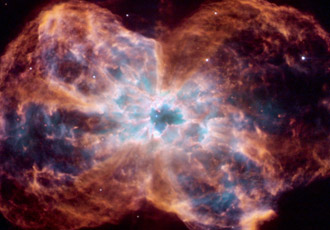Hubble's secondary camera - with the wider field - produced a nice image of a star in the exploding phase

A new image taken by the Hubble Space Telescope shows the so-called "last hurray" of a star similar to our Sun. The image was taken on February 6, 2007 by the Wide Field Camera No. 2, also known as the Planetary Camera, which was designed and built at NASA's Jet Propulsion Laboratory in California. This is not the camera that broke down in Hubble - the one that broke down is the advanced camera for surveys - whose field of view is narrower and it is designed for photographing distant galaxies. Without a choice, Hubble will have to use the planetary camera more and get the most out of it.
A star ends the must by shedding the outer layer of gas that created a sort of envelope around the remnants of the star's core. The star that consumed its hydrogen has now become a white dwarf and is the white dot in the center of the image. Our sun will consume the hydrogen and surround itself with stellar debris, in about 5 billion years.
Our Milky Way is dirty with these stellar remnants called planetary nebulae. This object has nothing to do with planets. Astronomers in the 18th and 19th centuries called them so because in small telescopes they resembled the disks of distant planets such as Uranus and Neptune.
The planetary nebula in the picture is called NGC 2440. The white dwarf in the center is one of the familiar hot ones. Its surface temperature is about 200 thousand degrees Celsius. The chaotic structure of the nebula indicates that the star dispersed its material in stages. In each such outburst, the star threw the material in a different direction. This can be seen in two bow tie-like lobes. The nebula is also rich in dust clouds, some of which form long dark lines pointing outward from the star. NGC 2440 is about 4,000 light-years away from Earth in the direction of the Canis Minor group.
The colors in the picture correspond to the materials that were blown from the star. Blue describes the helium, blue-green the oxygen and red the nitrogen and hydrogen.
For more images of the NGC 2440 nebula

6 תגובות
Father, how old are you and how long have you been studying physics and astronomy? I didn't really understand the article. I'm 12 years old. I've been learning about space for a long time and there are a lot of things I didn't understand. Why does it take so long to launch spacecraft that will take off to the moon or Mars? Why does it take so long? You know that Lockheed Martin, the well-known aircraft company that beat Boeing, won a huge contract of a trillion dollars. Describe to you what contribution this was to space. Why does America need fighter jets? Are they at war? We could launch powerful telescopes that are already blessed, speed up the nanotechnology processes, develop anti-matter engines that disrupt gamma radiation, but airplanes!! And what other planes could we reach Mars and build colonies on the moon!
1. This is a rapid dramatic explosion.
2. Some of the material emitted from the dead star reaches areas where there are concentrations of gases and dust and it enriches them with heavier materials, as well as destabilizing them and causing them to start forming new stars. The hydrogen that will still make up most of the mass of the new stars will come from the cloud of dust and gas in which they are found.
3. It's not one to one but a matter of subverting the nebula so that it starts producing stars.
There was indeed an attack. Let's hope she got through, although the system repelled most of it on its own. And of course I will delete the comments and blacklist the writers.
Can someone explain to me what is going on with the comment system here? How is it possible that malicious comments like the first three comments here enter here if every message has to be approved before it is published? Did someone hack the site?
Also, the last commenter's questions are very interesting, I also expect an answer, where is the owner of the house? Father are you here?
1. When the sun finishes using up all its hydrogen reserves, does it just gradually slowly expand until it becomes a nebula? Or is it a quick dramatic explosion?
2. I understood that nebulae of this type constitute a habitat for new suns, how is this possible? After all, the sun became a nebula after all the hydrogen in it was consumed, so how could new suns be formed without hydrogen? Where will he come from?
3. (I remembered another question) The substance in the nebula was created from a single sun, will its quantity be enough to create more than one new sun? Material is there from where or what?
Thanks in advance, and looking forward to the answers.
For Avi Bilozski, the Atentis is on the way, so the launch will be on NASA TV